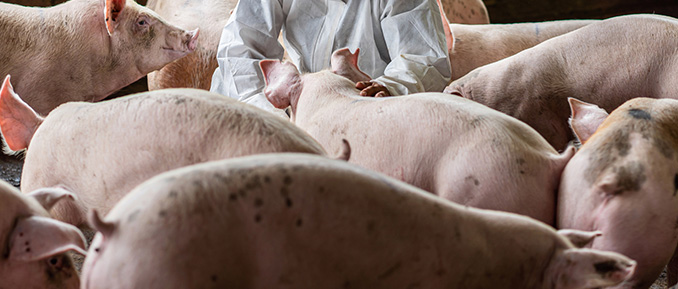
Years before COVID-19 emerged out of China and entered the US, a lesser-known, highly contagious coronavirus (CoV) had already hit US soil, causing an outbreak of severe diarrhea in pigs. This swine CoV, referred to as porcine epidemic diarrhea virus (PEDV), first appeared in the US in 2013. It caused high mortality and morbidity rates in the pork industry, spreading rapidly throughout the US then further into Canada and Mexico.
Although PEDV is not known to be transferable to humans, it is much like other CoVs, which are notorious for their ability to suspend innate immune response, contributing to an infection’s severity and persistence. Despite efforts to develop protection against PEDV using inactivated virus vaccines, the disease remains challenging to control, and still, no specific drug treatment for PEDV is currently available.
To better understand the biological processes involved in the development and persistence of this RNA type virus, scientists are exploring what biochemical changes, specifically epigenetic modifications, may be implicated in PEDV.
In a new study published in the September issue of Virology, N6-methyladenosine (m6A), the most prevalent RNA modifications, was investigated. While m6A modification has been associated with other viruses, such as certain types of influenza and HIV, this epigenetic study was the first to report on the occurrence of m6A in a coronavirus and its ability to alter viral regulation and host response.
Investigating epigenetics has allowed researchers to gain insight into the underlying causes of many viral infections. Epigenetic processes that have been well studied include DNA methylation, histone modification, and RNA methylation. Of the later, m6A is considered the most dynamic and abundant chemical modification of RNA (or mRNA) that can alter gene expression. It exists in nearly all eukaryotic organisms, including animals, plants, and fungi, and is regulated by three protein groups: methyltransferases (writers), demethylases (erasers), and m6A-binding proteins (readers).
The presence of m6A in virus infections was discovered nearly 50 years ago, however, only recently have scientists been able to examine its role. Newer methods like antibody-based immunoprecipitation followed by high-throughput sequencing have made transcriptome-wide profiling of m6A RNA modifications possible. Nevertheless, there is still much to learn about the function of m6A during virus infection.
Because PEDV is known to be one of the largest RNA viruses with a complicated structure, the researchers of this study set out to determine whether m6A was present within its genome and looked for how the modification affected viral replication.
Using a commercial assay kit, the researchers confirmed the presence of m6A in PEDV genomic RNA, reporting that it was approximately 0.05–0.06% of the total adenosines.
Additional analysis then revealed that PEDV replication was diminished by m6A in various cell lines. The knockdown of methyltransferases METTL3 and METTL14 increased replication, whereas the demethylase FTO knockdown suppressed replication.
Viral RNA replication was also affected. During PEDV infection, the percentage of m6A modification increased while FTO decreased. Plus, FTO overexpression was found to reverse host response, indicating that m6A plays an important role in regulating host viral replication.
Although more research is needed to detail the specific sites modified by m6A, the most significant takeaway from this study is that it is the first to identify the m6A modification in a coronavirus and its capacity for regulating both virus and host response –something that should be further explored in other types of coronaviruses, most notably the novel SARS-CoV-2, the virus responsible for COVID-19.
As the researchers reported, “Our study suggests that m6A modification may represent a novel and conserved target for antiviral mechanisms. We believe that the results from this study will facilitate the understanding of the role of m6A and broaden our knowledge on virus-host interactions at the RNA level.”
Source: Chen et. al.N6-methyladenosine regulates PEDV replication and host gene expression Virology. 548:59-72.

